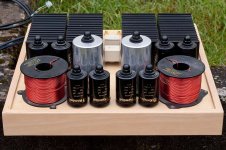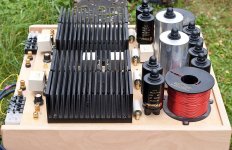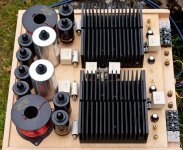Here a new approach for an active crossover network (high pass): To get enhancement by the dynamic range in a very high quality audio system of one of my customers I have decided to introduce an active crossover network.
But the disadvantage is, that there are additional active components such operational amplifiers in the path of the signal.
But what about, if I use the ZEN topology itself as operational amplifier?
Because the ZEN isn't power source follower (it is a grounded source) I cannot use the "Sallen Key" topology. Instead of this I must use the so called "multiple feedback" topology.
But one disadvantage there is without additional operational amplifiers: a too low open loop gain. Therefore I have make a combination of both, i. e. active and passive network for the high pass.
The result is to see in the attachement. That work I have performed already 6 years ago. Now the PHL bass-midrange (Typ 1230) will be replaced by a pure midrange, again from PHL. For this reason, the crossover frequency must be increased to approximately 500 Hz and therefore I get back this single ended ZEN special amp to do this re-match. From this ZEN device I have make three photos (see below)
I would be interested to know whether there are experience with an active crossover by ZEN projects without additional operational amplifiers.
Thank you very much
But the disadvantage is, that there are additional active components such operational amplifiers in the path of the signal.
But what about, if I use the ZEN topology itself as operational amplifier?
Because the ZEN isn't power source follower (it is a grounded source) I cannot use the "Sallen Key" topology. Instead of this I must use the so called "multiple feedback" topology.
But one disadvantage there is without additional operational amplifiers: a too low open loop gain. Therefore I have make a combination of both, i. e. active and passive network for the high pass.
The result is to see in the attachement. That work I have performed already 6 years ago. Now the PHL bass-midrange (Typ 1230) will be replaced by a pure midrange, again from PHL. For this reason, the crossover frequency must be increased to approximately 500 Hz and therefore I get back this single ended ZEN special amp to do this re-match. From this ZEN device I have make three photos (see below)
I would be interested to know whether there are experience with an active crossover by ZEN projects without additional operational amplifiers.
Thank you very much
Attachments
Interestingly enough, I noted the similarity between the topology of discrete opamps and j-aleph, or my own variant, LTP Zen.
I was interested in the idea of using a zen amp with Linkwitz transform feedback to extend the lf response of a subwoofer.
Because you use an additional differential input stage, there are more open loop gain than the orig. ZEN with only one stage, (voltage and current at the same time). Thus you can calculate as by normal op amp active crossover. Additional you can use two modes: the non inverted mode for "Sallen-Key" topology and the inverted mode for the MFB topology (multiple negative feed back). I would prefer the last for your fourth order acoustical 24db Linkwitz Riley high pass transfer function (12-18db BU characteristic actice crossover in combination with some passive components for mesured 24db Linkwitz Riley high pass transfer function).
Please note by creating of actice crossover - the Sallen-Key topology (multiple positive feed back) is only recommend for low pass function at low frequencies below approximately 300Hz (e. g. sub woofer), because the higher distortions there not critical.
Because a continuous control of the crossover frequency is easily to realize, this topology is used here in most cases.
Last edited:
in this case this thread is of interest:Are there no others uses single ended power amps for tweeters and integrated crossover networks?
http://www.diyaudio.com/forums/pass-labs/198617-first-watt-112-109-db-speakers.html
who have tested in the meantime the approach from second PDF in post #1 (active crossover network without additional OP-amps resp. transistors) ?
I have try various additional external crossover networks e. g. with OPA627 and several LMEs, unfortunately without inaudible effects.
Obviously additional stages provides at least in the upper frequency range only disadvantages in sonic character.
However, I have not yet examined the latest generation from TI (OPA992 etc.).
https://www.ti.com/lit/ds/symlink/o...472166&ref_url=https%3A%2F%2Fwww.google.de%2F
I have try various additional external crossover networks e. g. with OPA627 and several LMEs, unfortunately without inaudible effects.
Obviously additional stages provides at least in the upper frequency range only disadvantages in sonic character.
However, I have not yet examined the latest generation from TI (OPA992 etc.).
https://www.ti.com/lit/ds/symlink/o...472166&ref_url=https%3A%2F%2Fwww.google.de%2F
Last edited:
- Home
- Amplifiers
- Pass Labs
- ZEN include active crossover without additional OP AMP for ultimate sounding PHL1230


